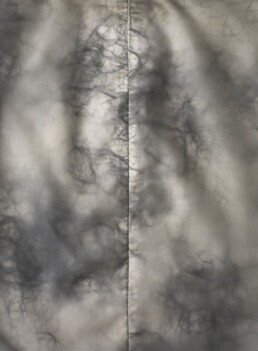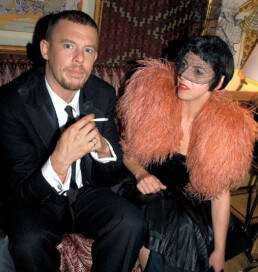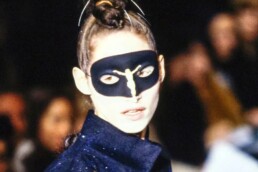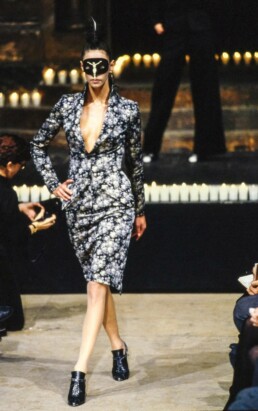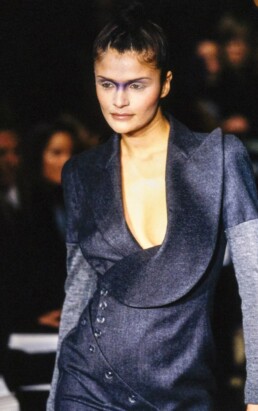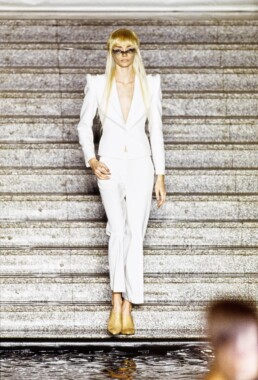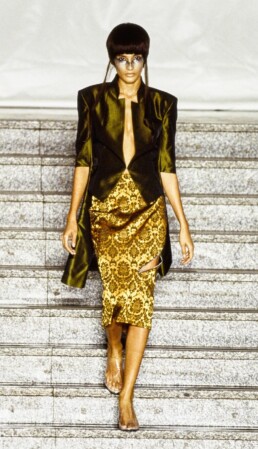ALEXANDER McQUEEN
The First Collections (1992 - 1997)

More than anything else in the world, at 21 years old, Alexander McQueen wants to be a fashion designer. He embarks on a bold journey to flip the fashion industry on its head. But what makes his early collections so revolutionary and controversial? And what leads to him being ‘discovered’? Join me on Part 2 of my Alexander McQueen series to find out.
Below you’ll find the companion gallery for this episode. It explores the imagery and video footage of McQueen’s first collections, as discussed in the episode, between the years 1992 – 1997. This forms a pivotal point in his career, in which we can trace the trajectory from the moment Isabella Blow discovers McQueen in the St. Martins’ graduate show to the La Poupée collection five years later which signals his status as an haute couture designer.
Jack the Ripper Stalks His Victims, Graduate Collection (1992)
Lee Alexander McQueen’s graduate collection, Jack the Ripper Stalks His Victims, debuts on July 1992 at London’s Kensington Olympia exhibition center. Most notable elements of this first unofficial collection are the Victorian inspired designs, barbed thorn frock coat, suggestion of violence, tailored sleeves, dark thematic material, and the alteration of the body’s silhouette.
When viewing the video footage, make note of the third and ninth models, whose jackets have unique silhouette aspects that transform their body’s forms. “What I distinctly remember is that if you looked at the collection from the side rather than from the front, you saw this extraordinary silhouette, a bird-like silhouette.” John McKitterick
Issie & Alexander
Isabella Blow, an editor of British Vogue magazine, attended the Central St. Martins graduate show in July 1992 hoping to view the new talent coming out of the school that year. What she was not expecting to witness was the visionary talent of a young man who, at first, was very suspicious about her adoration—Alexander McQueen. Issie later stated:
“I was sitting on the floor, I couldn’t even get a seat at the Saint Martins show, and the pieces went past me and they moved in a way I had never seen and I wanted them. They were modern and they were classical. The colors were very extreme. He would do a black coat, but then he’d line it with human hair and it was blood red inside so it was like a body—like the flesh, with the blood. And I just thought, this is the most beautiful thing I’ve ever seen…I just knew he had something really special, very modern, it was about sabotage and tradition.” Isabella Blow
Nihilism, S/S (1994)
“I want to empower women. I want women to be afraid of the women I dress.” Alexander McQueen
The most notorious looks from this collection feature models tightly wound in saran wrap—with the transparent plastic splattered in red mud that drips across the subtle folds like blood, their nude flesh showing through. It’s a shocking image. But even here, you can see that the tightly wound saran wrap around one model is cut perfectly to resemble a sleeveless minidress. What is McQueen trying to say with these plastic wrap dresses?
The newspaper, The Independent, reviewed the show stating: “McQueen, who is 24 and from London’s East End, has a view that speaks of battered women, of violent lives, of grinding daily existences offset by wild, drug-enhanced nocturnal dives into clubs where the dress code is semi-naked…a catalogue of horrors…tasteless innovation…the high price of originality.”
Video footage of McQueen’s Nihilism show (may only be playable on YouTube after signing in due to nudity):
The Birds, S/S (1995)
“Though avian prints appeared in this show—on the likes of Voguette Plum Sykes and the waist-training corsetiere Mr. Pearl—its title paid homage to Alfred Hitchcock’s 1963 thriller about violent bird attacks. Throughout his career Alexander McQueen would be drawn, like a magnet, to the theme of destruction, present in this collection in the tire tread print, and, structurally in the tailored deconstruction that became his signature.” Vogue
Highland Rape, A/W (1995)
McQueen’s most controversial show to date, Highland Rape was the ultimate embodiment of art & provocation. Originally inspired by the dark history of Scotland, the collection became a source of heated debate even among people who had never viewed a fashion show.
Highland Rape is a subject of personal heritage for McQueen, who grew up hearing stories from his mother, Joyce, about his distant ancestors on the Scottish side of his family tree. Stories of violent uprisings, betrayals, and the cruelties of war. This is what the title refers to, and in complete dedication to the theme he includes his own red McQueen tartan in many of the designs. At times he turns it into the pattern on a suit jacket, or a skirt, or a see-through blouse paired with tartan sleeves. But when it does appear, it carries with it an aura of strength, resilience, and defiance. It’s a fabric woven with pride.
Vivienne Westwood's Anglomania (1993)
Other fashion designers have used the famous Scottish tartan pattern in their collections. To McQueen, most often this resulted in superficial assimilation of the tartan. In one interview, he specifically references the use of the tartan in British designer Vivienne Westwood’s work. Here are examples from her Anglomania (1993) collection that illustrate what McQueen must have been referring to.
“They completely misunderstood Highland Rape. It wasn’t anti-woman. It was actually anti the fake history of Vivienne Westwood. She makes tartan lovely and romantic and tries to pretend that’s how it was. Well, eighteenth century Scotland was not about beautiful women drifting across the moors in swaths of unmanageable chiffon.” Alexander McQueen
Is Westwood’s use of the tartan tone-deaf or inappropriate? Perhaps what irked McQueen on a personal level was that Westwood was English by bloodline, and therefore, had no direct Scottish lineage to warrant such innovations. To McQueen, history and its rippling associations are an ever-present truth.
Dante, A/W (1996)
March 1st, 1996, McQueen stages one of his most critically acclaimed collections to date, he calls it Dante, it’s partially inspired by Dante’s Divine Comedy. The venue is a derelict cathedral. He also acquires a significant backer who contributes 30,000 pounds to the production of the show. Sitting in the front row are his mother, Joyce, his friend and unofficial business advisor, Isabella Blow, and a full sized anatomical skeleton. McQueen dedicates the Dante show to Isabella Blow.
Commenting on the spectacle afterward, journalists proclaim that he hit a ‘fashion moment’ with Dante. The International Herald Tribune wrote
“[McQueen] proved that he is not just a fine tailor with a soaring imagination, but one of those rare designers who capture the spirit of the times.” The fashion writer for The Sunday Times, Colin McDowell, interviews McQueen. In a twist of serendipity, McDowell is the author of the first book on fashion which McQueen read when he was a teenager, titled McDowell’s Directory of Twentieth Century Fashion. Now McDowell writes an article about McQueen calling him “the most stimulating designer of the moment…his desire to sweep away the barriers of taste might be the kick-start that fashion needs as we approach the millennium.”
Bellmer La Poupée, S/S (1997)
The title and theme for the designs of this collection was inspired by the artwork of German artist, Hans Bellmer. Specifically his photography work in which he deconstructed dolls and rearranged body parts into new formations. The term, La Poupée, is French for The Doll. This was partially one of McQueen’s not-so-subtle digs at the vapid consumerism of the fashion industry, and the objectification of women’s bodies.
But in another more interesting sense, McQueen may have seen himself as Hans Bellmer, playing with dolls and dressing them for his artistic whims—though in this case, his dolls were supermodels like Debra Shaw and Kate Moss. And where Bellmer’s ‘strangest’ impulses were private, McQueen’s were a very public fetish.
Hans Bellmer, shown below, using dolls as subjects of his photography.
“On September 27th, 1996, at the Horticultural Halls, the fashion world experienced a catwalk show that looked like an artwork in itself. The audience watched as the first model walked down a flight of stairs and onto the mirrored black surface; the realization that the girl was walking through water drew a collective gasp of surprise and delight from the crowd.
The models, including Kate Moss, Jodie Kidd, and Stella Tennant, wore Perspex wedge-heeled shoes and they appeared, quite literally, to walk on water.” Alexander McQueen: Blood Beneath the Skin, Andrew Wilson
The reason La Poupée stands as a turning point collection for Alexander McQueen is because with it he demonstrated his designs not only grabbed the public’s attention, but he also had the vision to create clothing that was commercially viable. Behind the provocation was a mind that understood the balance between art and product.
View the whole show of Bellmer La Poupée in the video below. (Due to nudity it may require viewing on YouTube.)
PATREON
Become a patron of the show, and gain access to all the exclusive Creativity Tip episodes, as well as episode exclusives. Just click the button or head over to: https://www.patreon.com/mjdorian
Wanna buy me a coffee?
This show runs on Arabica beans. You can buy me my next cup or drop me a tip on the Creative Codex Venmo Page: https://venmo.com/code?user_id=3235189073379328069&created=1629912019.203193&printed=1

